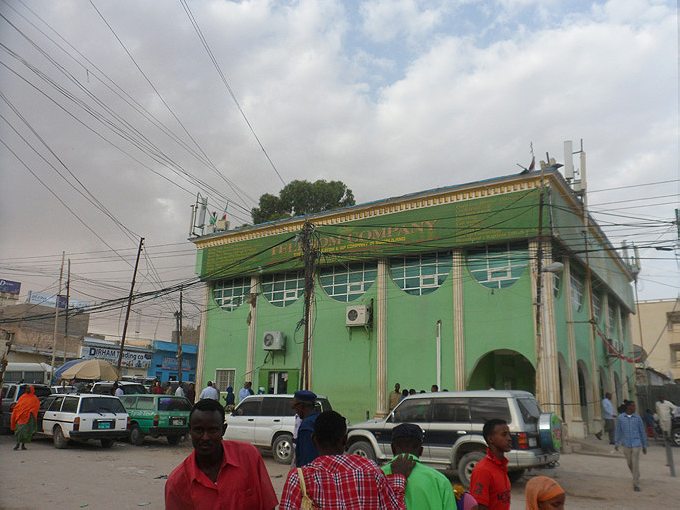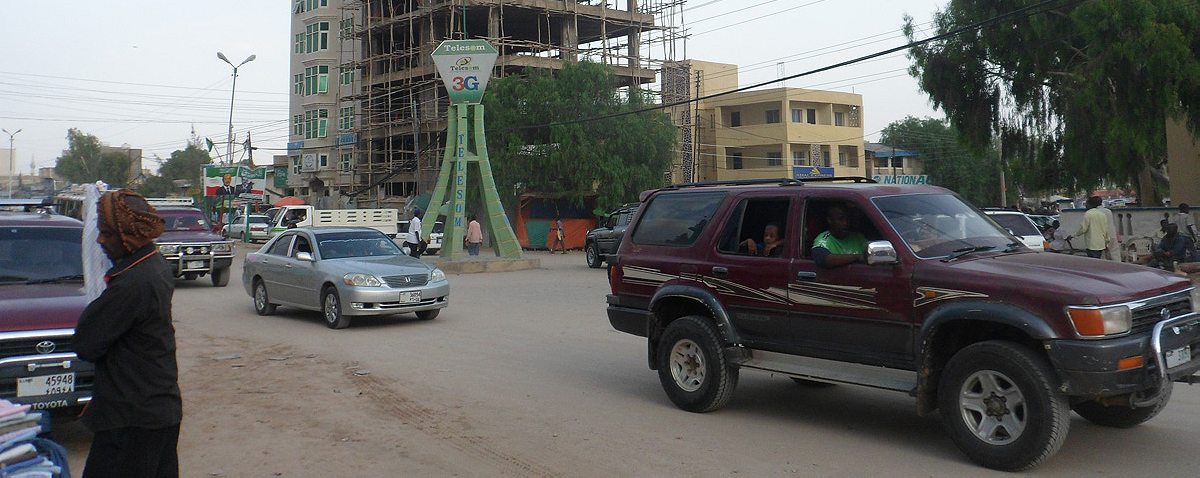Somaliland has embraced cell phone payments like few other countries. Can it SMS its way to an economic rebound?
By the murky green-blue ocean in northwest Somaliland, there is an open-air café with no name. There is only one item on the menu. Patrons compete with hordes of flies and mangy street cats for fresh tuna pulled from the ocean, bisected, peppered, and grilled. This coastal town, Zeila, population 8,500, has no agriculture or industries to speak of, much less commodities, investors, or tourists (unless one counts the migrants regularly shuttling back and forth from the Djibouti border). The only roads back to civilization are a series of diverging wheel ruts vanishing into the desert.
That’s why I’m amazed when, after my friends and I eat through 90,000 Somaliland Shillings (about $13.50) worth of fish, Saeed takes out his cellphone, glances at a number crudely stenciled on the corrugated tin wall, and tells me that our bill has been paid with ‘Zaad.’ I had been dreading counting out the cash in devalued Somaliland Shillings, which only come in denominations of 500, 1,000, and 5,000 (and those 5,000 notes are rare.)
Zaad is a mobile payment system that is radically transforming commerce and finance in Somaliland. At present, almost one-fifth of Somaliland’s population of 3.5 million are using Zaad to make payments. A higher percentage of people likely receive payments or interact in some other way with Zaad. The service, which has become ubiquitous in the past three years, has given Somaliland’s once stagnant economy a jolt. The simple fact of Somalilanders having access to cash on hand and being able to transfer sums has boosted the demand for consumer goods. It has enabled more and more shops to clog the streets and markets to move more expensive items—including current-model iPhones—off the shelves with relative ease.
Mobile money—moving personal cash around via cell phones—is not a new phenomenon in East Africa. In 2007, Kenyan telecom providers rolled out M-Pesa, a program that has become the poster-child of African mobile money. Tanzania and Uganda quickly followed, setting up their own mobile banking programs.

What makes Zaad special is the rapidity and extent to which it has permeated Somaliland society. Somaliland is one of the poorest and least connected countries in Africa. The de-facto independent nation broke away from Somalia in the early 1990s. A protracted civil war against Somalia’s dictator Siad Barre left Somaliland’s farms burned, ports ruined, and the main city of Hargeisa bombed to rubble. After the war, the country restored some small industry and set up taxes on sales at nomadic herders’ animal markets and hope to make a steady income from ports and fishing towns, but the specter of piracy, illegal fishing, and toxic waste dumping make that unlikely. Up to 40 percent of the population still depends on remittances from relatives abroad to survive. Yet, unlike any other nation with mobile banking, Somalilanders can pay most of their bills from their phones.
Until recently, there has been no financial infrastructure in Somaliland to speak of. The country just drafted legislation allowing the establishment of Islamic banking, which will comply with shariah law by forbidding interest on savings or loans. But the nascent Central Bank has yet to issue licenses, so the nation still has no banks. Before Zaad, Somalilanders either stored their cash with a hawala (an informal money transfer system, like Western Union but usually cheaper) or with local street vendors or moneychangers. Moving money around literally meant moving money around—bundles of cash would be loaded into an Isuzu truck and hauled from one town to the next. In a place like Zeila, a money truck might arrive once a week. No one recalls the trucks ever being robbed or vanishing, but cash did disappear.

When the telecommunications company Telesom introduced mobile banking to Somaliland in 2009, the effort was met with skepticism. To earn trust, Telesom paid its employees’ salaries via Zaad for two months before the service launched. Meanwhile they launched a massive ad campaign in the major cities, posting signs with the slogan “transfer, save, buy,” selling the system as a stand-in for the absent banks, in a country where buying a week’s food can require carrying around an armload of devalued bills. In more rural towns like Zeila, Zaad spread mostly by word of mouth.
ZAAD HAS FACED EXPECTED CRITICISM FROM AL-SHABAAB, THE ISLAMIC MILITANT GROUP
Zaad’s intuitive functionality was also important. Somaliland is plagued with chronically high illiteracy rates. To pay, one simply has to dial a three-digit start code, enter a four-digit pin, then type in a vendor number and confirm.
But Zaad has not been without its detractors. There have been the expected criticisms from al-Shabaab, the Islamic militant group, who condemn mobile banking as a Western plot to undermine Somaliland’s autonomy and security. But Somaliland’s press and policy intelligentsia have also been concerned that the rise of Zaad has contributed to the inflation of the Somaliland Shilling.
Zaad conducts all its transactions in US dollars. At the end of 2008 (the year before Zaad launched), one US dollar would get you 7,500 Somaliland Shillings, whereas today the rate is down to 6,600. However it’s quite difficult to prove that Zaad either improved the currency, had no effect, or prevented a stronger recovery.

Abdiwahab Maax Maxamed, an official at Telesom and one of the individuals involved in the launch of Zaad, shrugs off the criticism. “Inflation is not caused by this [Zaad],” he says. “Inflation is caused by the money flow of a foreign currency into the market. And the Central Bank should have control of the money flow.” He cites Kenya, where the popularity of M-Pesa hasn’t caused inflation. M-Pesa, however, conducts its transactions in Kenyan Shillings rather than a foreign currency. Other examples that Maxamed brings up—Zimbabwe and the Democratic Republic of Congo—do not inspire absolute confidence or credibility given the recent hyperinflation in the former and the rapid economic ups and downs in the latter.
Abdillahi Aden, The Director General of Somaliland’s Central Bank, says that the dollar has been prevalent in Somaliland with or without Zaad. The hunger for US currency is, after all, the raison d’etre for the moneychangers on every street. Additionally, Aden claims that once the Central Bank gets commercial banking off the ground (which, unlike Islamic banks, will involve interest payments and more complex financial instruments), they will transition to banking exclusively in Somaliland Shillings. Telesom says they are currently conducting feasibility studies to see if Somaliland Shillings can be used with Zaad as well.
IS MORE ZAAD A GOOD THING?
All of this may get more complicated sooner rather than later though, as Telesom has applied to the Central Bank for an Islamic banking license. After receiving their license, the phone company plans to open branches of Salaam Financial Services, a fully formed but as yet non-functional banking service they’ve been waiting to put online, to fuse banking services and mobile money services. At present, Zaad limits personal transfers to $500 and merchant transfers to $2,000. But with a bank at their disposal, there’s no telling how big Zaad could grow and how much more influence Zaad could have on the still-tiny Somaliland economy in the near future.
Is more Zaad a good thing? The short answer is: probably. For all Somaliland’s poverty, its lack of regulation on financial innovation has made it one of the most vibrant, wild frontiers for economic development. Whether or not Zaad has led to inflation (it appears unlikely that it has) seems almost irrelevant when considering the boost it has given to consumers and markets. And it’s likely to lift the economy a bit more as widespread trust in Zaad will probably accelerate popular acceptance of banks and banking services. Zaad is doing what Somaliland needs most: rescuing it from an economy based on money trucks and safe boxes.